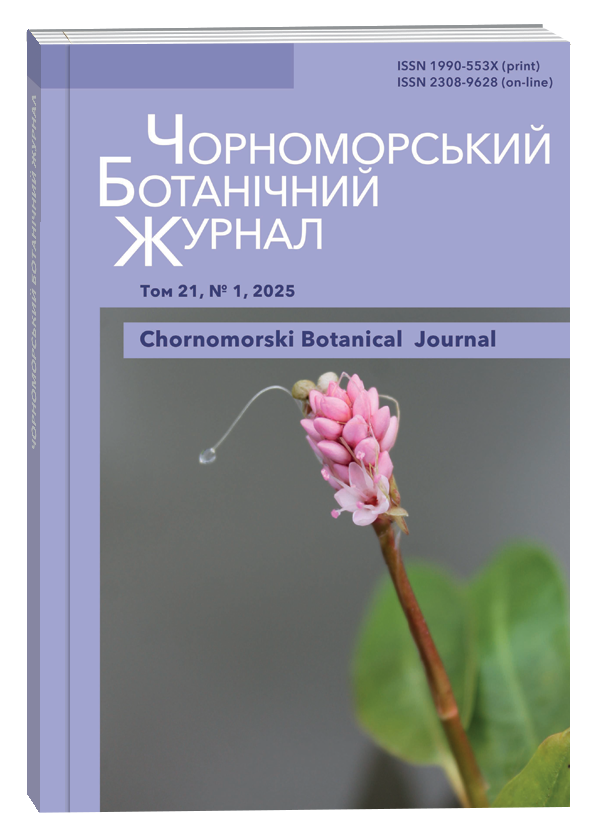Bryophytes of the National Nature Park “Tuzlivski lymany” (Odesa region, Ukraine)
DOI:
https://doi.org/10.32999/ksu1990-553X/2025-21-1-5Keywords:
biodiversity, bryoflora, substrate fractions, geographical elements, rare speciesAbstract
Question: What is the species composition of bryophytes in the National Nature Park “Tuzlivski lymany”? What are the substrate and geographical division of the bryoflora of the studied National Nature Park? Which rare species occur in the territory of the park? Location: Between villages Lebedivka and Katranka, Bilhorod-Dnistrovskyi district, Odesa region, Ukraine. Methods: Field collection, laboratory identification and structural analysis. Nomenclature: Virchenko & Nyporko 2022 Results: A total of 41 species of bryophytes (one species of liverworts and 40 of mosses) were established in the territory of the National Nature Park (NNP) “Tuzlivski lymany”. Representatives of Pottiaceae, Bryaceae and Brachytheciaceae prevail among mosses. These families are the richest in the whole steppe zone of Europe. Such substrate groups occur in the NNP: epigaeic (27 species), arenicolous (12), epiphytic (14), epixylic (3), artificial epilithic (10). Epigaeic and epiphytic bryophyte fractions are the most rich in the park. According to geographical system by A.J.E. Smith (2004) the bryophyte flora of the park includes boreal element (3 species), boreo-temperate (8), temperate (27) and sub-Mediterranean (Acaulon triquetrum, Rhynchostegium megapolitanum). One taxon, Physcomitrium arenicola appears to be endemic of Eastern Europe. Southern-temperate and sub-Mediterranean species are specific ones for the geographical structure of the bryophyte flora of the NNP “Tuzlivski lymany”. Eight moss species, specifically Bryum dichotomum, B. ruderale, Syntrichia papillosa, Tortula caucasica, Campylophyllopsis calcarea, Acaulon triquetrum, Physcomitrium arenicola and Rhynchostegium megapolitanum, are reported for the first time for the Odesa region. Among them the rare species Physcomitrium arenicola is included in the Red List of Bryophytes of Ukraine. Almost half of the bryophyte flora the Odesa region occurs in the NNP “Tuzlivski lymany”; thus, the species composition of the park is studied well enough. Conclusions: 41 species of bryophytes were established in the territory of the NNP “Tuzlivski lymany”. Representatives of Pottiaceae, Bryaceae and Brachytheciaceae prevail among mosses. Epigaeic and epiphytic bryophyte fractions are the most rich in the park. Southern-temperate and sub-Mediterranean species are specific ones for the geographical structure of the bryophyte flora. Eight moss species are reported for the first time for the Odesa region. Among them Physcomitrium arenicola included in the Red List of Bryophytes of Ukraine.
References
Bachurina, A.F. (1960). On the bryoflora of the southwest of Odesa region. Ukrainian Botanical Journal 17 (2): 83–88. (in Ukrainian)
Bachurina, A.F. & Boiko, M.F. (1975). Dopolnienie k kharakteristike mkha Physcomitrium arenicola Lazar. (Addition to the description of moss Physcomitrium arenicola Lazar.). Novitates systematicae plantarum vascularium et non-vascularum: 208–211 (in Russian)
Bachuryna, H.F. & Melnychuk, V.M. (1987). Flora mokhiv Ukrainskoi RSR. Vyp.1. Kyiv: Naukova dumka, 180 p. (in Ukrainian)
Bachuryna, H.F. & Melnychuk, V.M. (1988). Flora mokhiv Ukrainskoi RSR. Vyp. 2. Kyiv: Naukova dumka, 180 p. (in Ukrainian)
Bachuryna, H.F. & Melnychuk, V.M. (1989). Flora mokhiv Ukrainskoi RSR. Vyp. 3. Kyiv: Naukova dumka, 176 p. (in Ukrainian)
Bachuryna, H.F. & Melnychuk, V.M. (2003). Flora mokhiv Ukrainy. Vyp. 4. Kyiv: Akademperiodyka, 256 p. (in Ukrainian)
Boiko, M.F. (1999). The analisis of the steppe zone bryoflora of Europe. Kiev: Phytosociocentre, 180 p. (in Russian)
Boiko, M.F. (2009). Bryobionta of the steppe zone of Ukraine: monografy. Kherson: Ailant, 264 p. (in Ukrainian)
Boiko, M.F. (2010). Red List of Bryobionta of Ukraine. Rare and endangered species of Bryobionta of Ukraine. Kherson: Ailant, 94 p. (in Ukrainian)
Didukh, Y.P. & Shelyag-Sosonko, Y.R. (2003). Geobotanical division of Ukraine and adjacent territories. Ukrainian Botanical Journal 60 (1): 6–17. (in Ukrainian)
Dubyna, D.V., Dzyuba, T.P. & Yemelyanova, S.M. (2012). NNP “Tuzlivski lymany”. Phytodiversity of nature reserves and national nature parks of Ukraine. P.2. National nature parks. Kyiv: Phytosociocentre, 496–505. (in Ukrainian)
Karta gruntiv Ukrainskoi RSR. (1973). Odesa region. Kyiv: Ukrzemproekt. 1 m. (in Ukrainian)
Lazarenko, A.S. (1928). To study Ukrainian Funariaceae. Ukrainian Botanical Journal 4: 35–37. (in Ukrainian)
Lipinskiy, V.M. (ed.) (2003). Klimat Ukrainy. (Climate of Ukraine). Kyiv: Rayevskiy publishing house, 343 p. (in Ukrainian)
Popova, O.M. (2024). Taxonomical structure of flora of vascular plants of NNP “Tuzlivski lymany”. Materialy XV zyizdu Ukrainskoho botanichnoho tovarystva. Odesa: Helvetyka: 206. (in Ukrainian)
Mosyakin, S.L. & Fedoronchuk, M.M. (1999). Vascular plants of Ukraine: a nomenclatural checklist. Kiev: M.G. Kholodny Institute of Botany, 346 p.
Rudenko, L. (ed.) (2009). Natsionalnyi atlas Ukrainy. (National atlas of Ukraine). Kyiv: DNVP “Kartografia”, 440 p. (in Ukrainian)
Shyriaieva, D., Kubešova, S. & Virchenko, V.M. (2021). Rhynchostegium megapolitanum (Blandow ex F.Weber & D.Mohr) Schimp. In: Ellis L.T., Ah-Peng C., Aslan G. et al. New national and regional bryophyte records, 65. Journal of Bryology 43 (1): 82.
Smith, A.J.E. (2004). The moss flora of Britain and Ireland. Cambridge: Cambridge Univ. Press, 1012 p.
Virchenko, V.M. & Bolyukh, V.O. (1989). Rare bryophytes for the plain part of the Ukrainian SSR. Ukrainian Botanical Journal 46 (3): 71–76. (in Ukrainian)
Virchenko, V.M. & Popova, O.M. (2004). Materialy do brioflory Odeskoi oblasti (Materials to the bryophyte flora of Odesa region). J.K. Pachoski ta suchasna botanika. Kherson: 48–51 (in Ukrainian)
Virchenko, V.M. & Nyporko, S.O. (2022). Prodromus of sporen plants of Ukraine: bryophytes. Kyiv: Naukova dumka, 176 p. (in Ukrainian)




